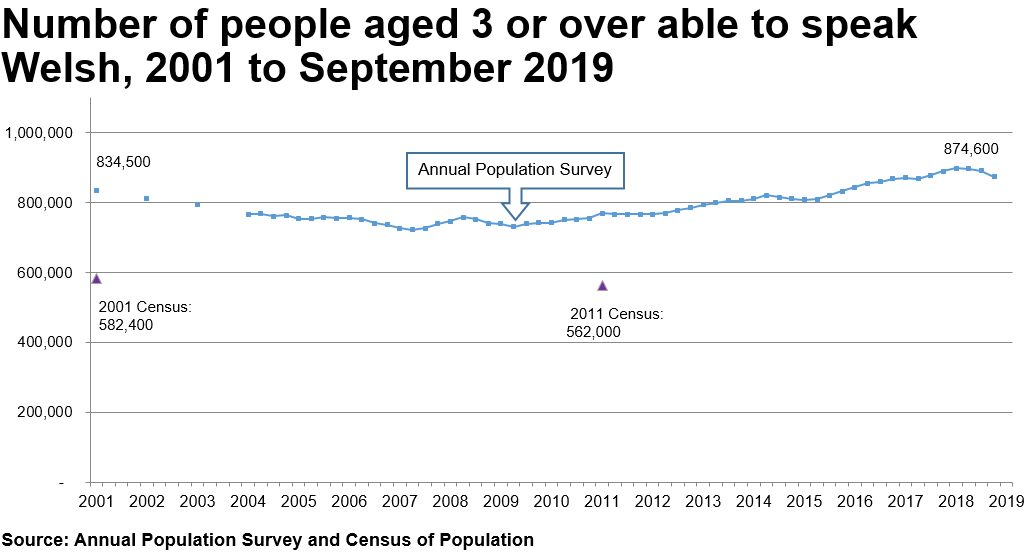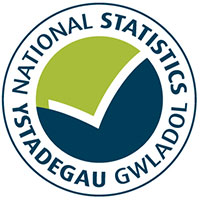Data on people’s ability in Welsh and how often they speak the language for October 2018 to September 2019.
This is not the latest release in the series: Welsh language data from the Annual Population Survey
The Census of Population is the key source used to measure the number of Welsh speakers in Wales. However, as the Annual Population Survey (APS) provides quarterly results, it is useful to use the APS to look at trends in the Welsh language between censuses

Main points
- For the year ending 30 September 2019 the APS reported that 29.0% of people aged three and over were able to speak Welsh. This figure equates to 874,600 people.
- This is 0.7 percentage points lower than the same quarter in the previous year (year ending 30 Sept 2018), equating to 14,600 fewer people.
- The chart shows how these figures have been gradually increasing each year since March 2010 (25.2%, 731,000), after they had been gradually declining from 2001 to 2007. However, this is the third successive quarter where the number of people able to speak Welsh has decreased.
- The highest numbers of Welsh speakers continue to be found in Carmarthenshire (93,400) and Gwynedd (90,300).
- The lowest numbers of Welsh speakers are in Merthyr Tydfil (10,800) and Blaenau Gwent (11,500).
- The highest percentages of Welsh speakers can be found in Gwynedd (76%) and the Isle of Anglesey (67%).
- The lowest percentages of Welsh speakers are in Bridgend (16%) and Blaenau Gwent (17%).
- 16.2% (489,200) of people aged three and over reported that they spoke Welsh daily, 5.1% (153,600) weekly and 6.2% (187,700) less often. 1.5% (44,400) reported that they never spoke Welsh despite being able to speak it, with the remaining 71.0% not able to speak Welsh.
- 34% (1,012,500) reported that they could understand spoken Welsh, 26% (785,800) could read and 24% (717,800) could write Welsh.
Note
The Census results and APS results for 2001 and 2011 have also been plotted on the chart above to indicate the large discrepancy between the two sources at the same time periods. There are a number of possible explanations for why Census results would be lower than survey results. For example, the Census is a statutory self-completion questionnaire, the APS is voluntary survey, which uses face-to-face interviews.
The APS results should not be compared against Census results, nor used to measure progress towards the Welsh Government target of a million Welsh speakers by 2050. The Welsh language strategy Cymraeg 2050, clearly states that this target was based on census data and that progress towards this target will be monitored using future census data.
A blog published by the Chief Statistician last year, gave a brief discussion on how to interpret the Welsh language data in the APS. More information about the differences between the APS and the Census can be found in a bulletin presenting more detailed results on the Welsh language from the APS from 2001 to 2018.
The APS is carried out by the Office for National Statistics (ONS). Details about how the survey is developed and carried out can be found on the Office for National Statistics website.
Contact
Lisa Walters
Telephone: 0300 025 6682
Email: welshlanguagedata@gov.wales
Rydym yn croesawu galwadau a gohebiaeth yn Gymraeg / We welcome calls and correspondence in Welsh.

